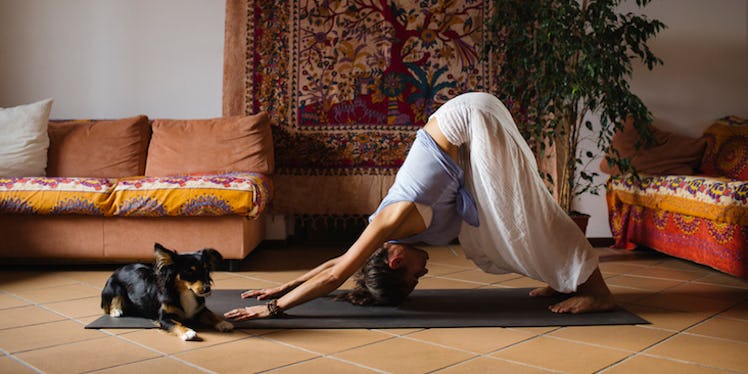
This One Yoga Pose Is All You Need To Stop A Pounding Headache Right In Its Tracks
Headaches are like breakups: They usually come out of nowhere, they hit you so much harder than you'd ever expect, and it can feel like the pain will last forever. In some ways, though, a headache can be a little bit better than a breakup, in that there are more concrete ways to go about relieving the pain. Whether or not you take painkillers like ibuprofen is up to you, but even with the medicine, you might still be left with a dull, aching sensation that just won't quit. In that case, you need the best yoga pose for headaches to rescue you from your pain ASAP.
As I'm sure you already know, one of yoga's best benefits is its ability to relieve stress. And since stress often plays a huge role in amplifying, or even inducing headaches, combining deep, relaxing breaths with a headache-busting yoga pose will help remedy your pain in no time.
In addition to stress, Shape reports, unnecessary bodily tension in your neck, shoulders, and spine might be contributing to your headache, as well. But don't worry — that tension can also be effectively remedied by simply rolling out your mat and finding your way into this one simple, soothing yoga pose.
If you have time for a whole yoga sequence, that's awesome. If you don't, downward facing dog — or adho mukha svanasana in Sanskrit — is really the only pose you need to ease your tension headache.
Downward facing dog is one of yoga's most well-known poses, and for good reason. This bad boy basically does it all: Adho mukha svanasana opens up your shoulders and spine, while releasing tension in your neck and encouraging blood flow to your head. This asana is also considered to be a minor inversion, because your head is below your heart — which, believe it or not, is actually even more effective for banishing brain pain, because your head can hang loosely and your shoulders can relax.
While you're in this pose, make sure your fingers are spread out wide on your mat, with your ears level in between your arms. Raise your hips toward the sky, gaze toward your belly button, and breathe into the luxurious stretch in your hamstrings. Try your best to focus on these other bodily sensations, rather than the persistent pounding in your head.
Once you've accomplished your foundation in the pose, consider closing your eyes and breathing deeply and expansively, taking full, indulgent inhales into your belly and long, drawn-out exhales out of your nose.
If you really want to make sure your headache gets out and stays out, adding some lavender essential oils to your downward facing dog pose will truly take things to the next level.
According to Dr. Josh Axe, D.N.M., C.N.S., D.C., founder of DrAxe.com, best-selling author of Eat Dirt, and co-founder of Ancient Nutrition, lavender essential oil can be great for headaches not just because it smells divine, but also because it "regulates serotonin levels, which helps minimize pain in the nervous system." In other words, the lavender can basically seep into your skin upon application and soothe your pain from the inside out. Pretty awesome, right?
Try taking a few drops of lavender essential oil and rubbing it straight onto your temples (be sure to check the label and dilute with water if necessary!). You can even experiment with dabbing a tiny bit of the oil above your upper lip, so you'll be able to inhale the blissful and soothing scent with ease while you're in your downward facing dog pose.
The combination of this therapeutic essential oil with the healing properties of downward facing dog will restore balance in your body, and before you know it, the pain in your head will slowly melt away.
Of course, if your headaches don't seem to go away, even after trying yoga, essential oils, and deep breathing, make sure you talk to your doctor about what's going on, so you can get the right treatment for your individual body.
This article was originally published on